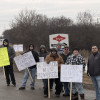With the COVID-19 pandemic still a threat, the 34th Consolidated Convention will convene in a virtual format. Pulling up a chair and logging on is an easy and safe way to meet. But what did Boilermakers do over a century ago? How did they go about forming an international union without the wide use of telephones or automobiles? Today, with just about everyone carrying a phone in their pocket, that seems impossible. But back then, the urgency and drive to form a union was an issue of life or death, so workers found a way.
Back in the late 1800s, local unions were organized as individual branches with no direct connections to Boilermakers in other cities, or even to other railroad shops located in the same town. Yet workers realized the problems they faced were bigger than their own local branch. With owners holding all the cards, death on the job and long workdays for low wages were common. An extensive list of horrible working conditions and practices pushed separate branches to organize together for power.
On Oct. 1, 1880, a group of Boilermakers met in Chicago, but the records are vague on how they communicated or on how they discovered other lodges tucked away in various cities. In the late 1880s, telephones had just been invented, letters were slow and telegrams were expensive.
In whatever way the message got out, representatives from nine local branches (now called local lodges) found a way to meet in Chicago. According to union lore, the men met secretly in the back of a tavern while the sympathetic owner watched for police and private detectives, who sometimes violently broke up meetings of workers hoping to form a union. By the end of the evening, the nine branches had become the National Boiler Makers Protective and Benevolent Union. The group incorporated under the laws of the state of New York, with newly organized branches charted as sub-branches.
Other groups of Boilermaker branches that had formed in Ohio and San Francisco joined the Chicago group, causing the union’s rapid growth. In August of 1881, 23 delegates attended the first annual convention. A year later, 68 delegates convened, representing over 30 unified branches.
The first Boilermaker lodge in Canada—Branch 21—was organized August 6, 1884 in Hamilton, Ontario, on the same day the third national convention opened in Cincinnati with 82 delegates from more than 40 branches.
It may always remain a mystery just how separate branches from across North America found other branches for that fateful meeting in the back of a Chicago tavern. Even so, this summer the Boilermakers union carries on the tradition started 140 years ago. And by doing so, workers continue to defend the power of the labor movement.






